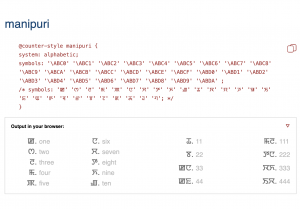Category: ilreq
Posts
WEB I18N GAP FIXED: Interoperable custom counter styles
All 3 major browser engines now support the ability to create custom counter styles.
This is a significant step forward in enabling fully interoperable list numbering and other counters that reflect local approaches, especially for languages with smaller speaker populations.
See the Gap report.
See also Ready-made Counter Styles to use or adapt almost 200 suggested patterns from around the world.
Updated: Ready-made Counter Styles
The Ready-made Counter Styles document provides ready-made definitions for counter styles and covers the needs of a range of cultures around the world. The code snippets provided in the document can be included in style declarations by simply copying and pasting, or they can be use as a starting point and modified as desired.
This update brings the total number of style templates to 177, covering 44 writing systems.
Substantial changes were also made to the styling and presentation. Each template is now accompanied by a set of examples, as well as an icon that copies the template to your clipboard in a single click. Another icon points to MDN’s roundup of browser support for named styles. Extensions to cover affix variants are now expressed in terms of the extends syntax.
Fixes were applied for tai-lue and warang-citi styles.
Finally, a button is provided to allow you to turn off all counter styling for the examples. That then allows you to see which styles have built-in support in the browser you are using.
First Public Working Draft: Gurmukhi Layout Requirements
This document describes aspects of layout and presentation of text in the Punjabi language using the Gurmukhi script. It is developed in conjunction with a document which summarizes gaps in Gurmukhi support on the Web and eBook technologies.
The document has been published to encourage users and experts to review the information it currently contains, and provide any additional information that may be relevant to supporting users of the Gurmukhi script on the Web.
Please send comments by raising a GitHub issue for each point.
New article: Font styles & font fallback
The article Font styles & font fallback has now been published.
This article provides a non-exhaustive set of examples where choice of a font style may have a practical application. The existence of these distinct styles, with their practical influence on the reading of the text, has implications for fonts on the Web – you would typically want to choose a fallback font that has the same style, if one is available. We look at some implications for generic fonts and fallback mechanisms near the end.
For review: Font styles & font fallback
The article Font styles & font fallback is out for wide review. We are looking for comments by Thursday 3 November.
This article provides a non-exhaustive set of examples where choice of a font style may have a practical application. The existence of these distinct styles, with their practical influence on the reading of the text, has implications for fonts on the Web – you would typically want to choose a fallback font that has the same style, if one is available. We look at some implications for generic fonts and fallback mechanisms near the end.
Please send any comments as github issues by clicking on this link, or on “Leave a comment” at the bottom of the article. (That will add some useful information to your comment.)
Updated article: Approaches to full justification
This article gives a high level summary of various typographic strategies for fully justifying text on a line and in a paragraph for a variety of scripts, and offers some advice to authors and implementers.
The section about SE Asian justification was rewritten as South & Southeast Asian Writing Systems, adding more detail, and shows examples for Tamil of inter-glyph stretching (as opposed to inter-character).
Ready-made Counter Styles updated
Until now, only Gecko browsers (eg. Firefox) provided support for CSS counter styles, but an update of Blink last week brought very welcome support to a much wider range of users (via browsers such as Chrome and Edge, etc.).
To coincide with this release, the Internationalization WG updated the WG Note Ready-made Counter Styles. This contains templates for counter styles used by various cultures around the world. It can be used as a reference for those wishing to add user-defined counter styles to their CSS style sheets.
The changes include the addition of new styles for scripts including adlam, hanifi-rohingya, lepcha, meetei, santali, ethiopic and chinese. Instructions were also added for those wanting to use different suffixes or prefixes, according to the context in which the counter style is used.
Article published: Typographic character units in complex scripts
CSS defines the typographic character unit as a basic unit of text for use with editing operations, however the meaning of that term can vary according to the operation, and there are issues in working with such units in complex scripts. In this article we look at examples of some of those differences and issues.
For review: Typographic character units in complex scripts
The article Typographic character units in complex scripts is out for wide review. We are looking for comments by Thurday 25 February.
CSS defines the typographic character unit as a basic unit of text for use with editing operations, however the meaning of a that term can vary according to the operation, and there are issues in working with such units in complex scripts. In this article we look at examples of some of those differences and issues.
Please send any comments as github issues by clicking on this link, or on “Leave a comment” at the bottom of the article. (This will add some useful information to your comment.)
3 FPWDs for language requirements
Following on from the publication of gap-analyis documents as FPWD, three more documents have been published as FPWD that contain information about how Tamil, Mongolian, and Tibetan orthographies work. These documents are intended to support the gap-analysis work.
Tamil Layout Requirements
https://www.w3.org/TR/ilreq-taml/
Mongolian Layout Requirements
https://www.w3.org/TR/mlreq/
Requirements for Tibetan Text Layout and Typography
https://www.w3.org/TR/tlreq/
W3C® liability, trademark and permissive license rules apply.
Questions or comments? ishida@w3.org


